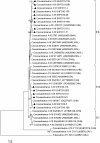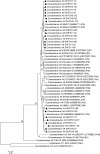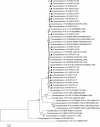Enterovirus genotypes causing hand foot and mouth disease in Shanghai, China: a molecular epidemiological analysis
- PMID: 24148902
- PMCID: PMC4015791
- DOI: 10.1186/1471-2334-13-489
Enterovirus genotypes causing hand foot and mouth disease in Shanghai, China: a molecular epidemiological analysis
Abstract
Background: A rapid expansion of hand, foot, and mouth disease (HFMD) outbreaks has occurred and caused deaths in China in recent years, but little is known about the other etiologic agents except enterovirus 71 (EV71) and coxsackievirus A 16 (CA16). The objective of this study is to determine the genotype compositions of enterovirus causing HFMD in Shanghai and identify any associations between enterovirus types and clinical manifestations.
Methods: Stool specimens were collected from patients hospitalized for treatment of HFMD, from May 2010 to April 2011. Enterovirus was detected by reverse transcription PCR and directly genotyped by sequencing the PCR products. Phylogenetic analysis was based on the VP1 partial gene.
Results: Of 290 specimens, 277 (95.5%) tested positive for enterovirus. The major genotypes were EV71 (63.8%), CA10 (9.0%), CA6 (8.3%), CA16 (6.9%), CA12 (2.4%), and CA4 (1.4%). The EV71 strains belonged to the C4a subtype and CA16 belonged to the B subtype. CA6 was closely related to strains detected in Japan, Taiwan and China, and CA10, CA12 and CA4 were phylogenetically similar to other strains circulating in China. Mean hospital stays and the prevalence of complications in patients with EV71 infection were higher than those in patients in CA6, CA10 or CA16 infection (P < 0.05 for all comparisons). Children with CA12 infection were the youngest, and most likely have the highest risk of complications when compared to the other non-EV71 infection groups.
Conclusions: This study demonstrated a diversified pathogen compositions attributing to HFMD and clinical symptoms differing in enterovirus genotypes. It deserves our attention as early identification of enterovirus genotypes is important for diagnosis and treatment of HFMD patients.
Figures




Similar articles
-
Genotypes of the Enterovirus Causing Hand Foot and Mouth Disease in Shanghai, China, 2012-2013.PLoS One. 2015 Sep 23;10(9):e0138514. doi: 10.1371/journal.pone.0138514. eCollection 2015. PLoS One. 2015. PMID: 26398767 Free PMC article.
-
Phylogenetic analysis of the major causative agents of hand, foot and mouth disease in Suzhou City, Jiangsu province, China, in 2012-2013.Emerg Microbes Infect. 2015 Feb;4(2):e12. doi: 10.1038/emi.2015.12. Epub 2015 Feb 25. Emerg Microbes Infect. 2015. PMID: 26038764 Free PMC article.
-
[Analysis on the change of genotype of enteroviruses associated hand, foot and mouth disease in Beijing during 2013 to 2014].Zhonghua Er Ke Za Zhi. 2015 Aug;53(8):610-5. Zhonghua Er Ke Za Zhi. 2015. PMID: 26717660 Chinese.
-
Coxsackievirus A6: a new emerging pathogen causing hand, foot and mouth disease outbreaks worldwide.Expert Rev Anti Infect Ther. 2015;13(9):1061-71. doi: 10.1586/14787210.2015.1058156. Epub 2015 Jun 25. Expert Rev Anti Infect Ther. 2015. PMID: 26112307 Review.
-
Coxsackievirus A16: epidemiology, diagnosis, and vaccine.Hum Vaccin Immunother. 2014;10(2):360-7. doi: 10.4161/hv.27087. Epub 2013 Nov 14. Hum Vaccin Immunother. 2014. PMID: 24231751 Free PMC article. Review.
Cited by
-
Development and characterization of a clinical strain of Coxsackievirus A16 and an eGFP infectious clone.Virol Sin. 2015 Aug;30(4):269-76. doi: 10.1007/s12250-015-3610-7. Epub 2015 Jul 24. Virol Sin. 2015. PMID: 26220729 Free PMC article.
-
Epidemic pattern of hand-foot-and-mouth disease in Xi'an, China from 2008 through 2015.BMC Infect Dis. 2019 Jan 7;19(1):19. doi: 10.1186/s12879-018-3624-5. BMC Infect Dis. 2019. PMID: 30616531 Free PMC article.
-
Clinico Virological Characterization of Hand, Foot and Mouth Disease in a Tertiary Care Hospital, South India.J Glob Infect Dis. 2023 Feb 10;15(1):13-18. doi: 10.4103/jgid.jgid_145_22. eCollection 2023 Jan-Mar. J Glob Infect Dis. 2023. PMID: 37090140 Free PMC article.
-
MST1/2 exerts a pivotal role in inducing neuroinflammation and Coxsackievirus-A10 replication by interacting with innate immunity.Virol J. 2024 Apr 19;21(1):89. doi: 10.1186/s12985-024-02355-5. Virol J. 2024. PMID: 38641810 Free PMC article.
-
Development of Novel Vaccines against Enterovirus-71.Viruses. 2015 Dec 30;8(1):1. doi: 10.3390/v8010001. Viruses. 2015. PMID: 26729152 Free PMC article. Review.
References
-
- Blomberg J, Lycke E, Ahlfors K, Johnsson T, Wolontis S, von Zeipel G. New enterovirus type associated with epidemic of aseptic meningitis and/or hand, foot, and mouth disease. Lancet. 1974;13:112. - PubMed
Publication types
MeSH terms
LinkOut - more resources
Full Text Sources
Other Literature Sources
Miscellaneous

